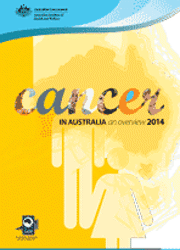Summary
Cancer in Australia: an overview 2014 was prepared by the Australian Institute of Health and Welfare with support from state and territory members of the Australasian Association of Cancer Registries. It provides comprehensive national information and statistics on cancer, including the latest available data and projections, as well as trends over time. Information by Aboriginal and Torres Strait Islander status, state and territory, remoteness area, life stages and socioeconomic disadvantage are also presented.
Cancer is a major cause of illness in Australia
In 2014, it is estimated that 123,920 Australians will be diagnosed with cancer (excluding basal and squamous cell carcinoma of the skin, as these cancers are not notifiable diseases in Australia). More than half (55%) of the cancer cases diagnosed in Australia are expected to be for males. The most commonly reported cancers in 2014 are expected to be prostate cancer, followed by colorectal (bowel) cancer, breast cancer in females, melanoma of the skin, and lung cancer. Between 1982 and 2014, the number of new cancer cases diagnosed more than doubled—from 47,417 to 123,920. This increase can be largely attributed to the rise in the incidence of prostate cancer, colorectal cancer, breast cancer in females and lung cancer. The increase can also be partly explained by the ageing and increasing size of the population, improved diagnoses through population health screening programs, and improvements in technologies and techniques used to identify and diagnose cancer.
Mortality rate due to cancer has fallen
In 2014, it is estimated that nearly 45,780 Australians will die from cancer. Cancer accounted for about 3 in 10 deaths in Australia. For all cancers combined, the age-standardised mortality rate is estimated to decrease by 20%, from 209 per 100,000 in 1982 to 168 per 100,000 in 2014.
Survival improved over time, but not consistent across all cancers
Five-year survival from all cancers combined increased from 46% in 1982–1986 to 67% in 2007–2011. The cancers with the largest survival gains over this time were prostate cancer, kidney cancer and non-Hodgkin lymphoma. People living in Australia who were diagnosed with cancer generally had better survival prospects compared with people living in other countries and regions who were diagnosed with cancer.
Cancer outcomes differ across population groups
Cancer outcomes differ by Aboriginal and Torres Strait Islander status and remoteness area. In 2008–2012, for all cancers combined, Indigenous Australians experienced higher mortality rates than non-Indigenous Australians. In 2005–2009, incidence rates were highest for those living in Inner regional areas of Australia; in 2008–2012, mortality rates were highest for those living in Very remote areas.
Mortality projections presented in this report have recently been revised using more recent data and are presented in the report Cancer mortality trends and projections: 2014 to 2025. In the process of updating the projections, changes have been made to the underlying models used in this report. Readers should therefore use the relevant mortality projections presented in the Cancer mortality trends and projections: 2014 to 2025 report instead.
Preliminary material: Acknowledgments; Abbreviations; Symbols
1 Introduction
- Purpose and structure of this report
- Data interpretation
- Data sources
- What is missing from the picture?
2 Risk factors, early detection and prevention
- Known risk factors for cancer
- Early detection through organised population screening
3 Incidence of cancer
- About incidence
- Estimated number of cases diagnosed
- Most commonly diagnosed cancers
- Differences by age
- Risk of being diagnosed with cancer
- Change over time
4 Hospitalisations and admitted patient palliative care for cancer
- About hospitalisations
- Hospitalisations in 2012–13
- Palliative care for cancer in the hospital setting
5 Survival after a diagnosis of cancer
- About survival
- Five-year relative survival
- Conditional survival
6 Prevalence of cancer
- About prevalence
- Cancer prevalence
7 Mortality from cancer
- About mortality
- Estimated number of deaths from cancer
- Most common causes of death from cancer
- Mortality by age
- Risk of death from cancer
- Change over time
8 Focus on key population groups
- Differences across population groups
- Aboriginal and Torres Strait Islander people
- State and territory
- Remoteness area
- Socioeconomic disadvantage
- Life stages
9 International comparisons
- About international comparisons
- Incidence
- Mortality
- Mortality-to-incidence ratio
Appendixes
Appendix A: Cancer codes
Appendix B: Summary pages for selected cancers
Appendix C: Cancer incidence, mortality and survival for all cancer groupings
Appendix D: Guide to online supplementary tables
Appendix E: Classifications
Appendix F: How estimated data in the 2011 Australian Cancer Database were calculated
Appendix G: Methodology for cancer projections
Appendix H: Statistical methods and technical notes
Appendix I: Data sources
Appendix J: Definition of cancer-related hospitalisations
End matter: Glossary; References; List of tables; List of figures List of boxes



